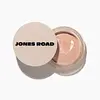What's inside
What's inside
 Key Ingredients
Key Ingredients

 Benefits
Benefits

 Concerns
Concerns

 Ingredients Side-by-side
Ingredients Side-by-side

Simmondsia Chinensis Seed Oil
EmollientRicinus Communis Seed Oil
MaskingLimnanthes Alba Seed Oil
Skin ConditioningCera Alba
EmollientOleic/Linoleic/Linolenic Polyglycerides
EmollientCocos Nucifera Oil
MaskingLauroyl Lysine
Skin ConditioningSilica
AbrasivePropanediol
SolventPentylene Glycol
Skin ConditioningTocopherol
AntioxidantMauritia Flexuosa Fruit Oil
Skin ConditioningEquisetum Arvense Juice
Skin ConditioningCalendula Officinalis Flower
Skin ConditioningHemidesmus Indicus Root Powder
Skin ConditioningCurcumin
AntioxidantWithania Somnifera Extract
Skin ConditioningMethyl Glycyrrhizate
MaskingOlea Europaea Leaf
Skin ConditioningCI 77891
Cosmetic ColorantIron Oxides
Simmondsia Chinensis Seed Oil, Ricinus Communis Seed Oil, Limnanthes Alba Seed Oil, Cera Alba, Oleic/Linoleic/Linolenic Polyglycerides, Cocos Nucifera Oil, Lauroyl Lysine, Silica, Propanediol, Pentylene Glycol, Tocopherol, Mauritia Flexuosa Fruit Oil, Equisetum Arvense Juice, Calendula Officinalis Flower, Hemidesmus Indicus Root Powder, Curcumin, Withania Somnifera Extract, Methyl Glycyrrhizate, Olea Europaea Leaf, CI 77891, Iron Oxides
Water
Skin ConditioningCaprylic/Capric Triglyceride
MaskingC12-15 Alkyl Benzoate
AntimicrobialCaprylic/Capric/Succinic Triglyceride
EmollientPropanediol
SolventSimmondsia Chinensis Seed Oil
EmollientOlea Europaea Fruit Oil
MaskingCoco-Caprylate/Caprate
EmollientDiisostearyl Malate
EmollientC9-12 Alkane
SolventPolyhydroxystearic Acid
EmulsifyingHydrogenated Castor Oil
EmollientRicinus Communis Seed Oil
MaskingHelianthus Annuus Seed Wax
Skin ConditioningStearalkonium Hectorite
Gel FormingEuphorbia Cerifera Wax
Polyglyceryl-3 Diisostearate
EmulsifyingPolyglyceryl-3 Polyricinoleate
EmulsifyingPhenoxyethanol
PreservativeCopernicia Cerifera Wax
Silica Silylate
EmollientSodium Chloride
MaskingPelargonium Graveolens Oil
MaskingTocopheryl Acetate
AntioxidantPolyglyceryl-6 Polyricinoleate
EmulsifyingTriethoxycaprylylsilane
Zingiber Officinale Root Oil
MaskingLecithin
EmollientSilica
AbrasiveBiosaccharide Gum-1
HumectantSodium Hyaluronate
HumectantMica
Cosmetic ColorantCI 77891
Cosmetic ColorantIron Oxides
Citronellol
PerfumingGeraniol
PerfumingLinalool
PerfumingLimonene
PerfumingCitral
PerfumingWater, Caprylic/Capric Triglyceride, C12-15 Alkyl Benzoate, Caprylic/Capric/Succinic Triglyceride, Propanediol, Simmondsia Chinensis Seed Oil, Olea Europaea Fruit Oil, Coco-Caprylate/Caprate, Diisostearyl Malate, C9-12 Alkane, Polyhydroxystearic Acid, Hydrogenated Castor Oil, Ricinus Communis Seed Oil, Helianthus Annuus Seed Wax, Stearalkonium Hectorite, Euphorbia Cerifera Wax, Polyglyceryl-3 Diisostearate, Polyglyceryl-3 Polyricinoleate, Phenoxyethanol, Copernicia Cerifera Wax, Silica Silylate, Sodium Chloride, Pelargonium Graveolens Oil, Tocopheryl Acetate, Polyglyceryl-6 Polyricinoleate, Triethoxycaprylylsilane, Zingiber Officinale Root Oil, Lecithin, Silica, Biosaccharide Gum-1, Sodium Hyaluronate, Mica, CI 77891, Iron Oxides, Citronellol, Geraniol, Linalool, Limonene, Citral
 Reviews
Reviews

Alternatives
Ingredients Explained
These ingredients are found in both products.
Ingredients higher up in an ingredient list are typically present in a larger amount.
Ci 77891 is a white pigment from Titanium dioxide. It is naturally found in minerals such as rutile and ilmenite.
It's main function is to add a white color to cosmetics. It can also be mixed with other colors to create different shades.
Ci 77891 is commonly found in sunscreens due to its ability to block UV rays.
Learn more about CI 77891Propanediol is an all-star ingredient. It softens, hydrates, and smooths the skin.
It’s often used to:
Propanediol is not likely to cause sensitivity and considered safe to use. It is derived from corn or petroleum with a clear color and no scent.
Learn more about PropanediolRicinus Communis Seed Oil is the INCI name for castor oil.
Castor Oil helps moisturize the skin. It is rich in a fatty acid called ricinoleic acid. This fatty acid helps prevent moisture loss on the skin. This helps keep your skin soft and hydrated. Ricinoleic acid also has anti-inflammatory and pain reducing properties.
Besides hydrating the skin, castor oil is also used to hydrate hair. By keeping the hair shaft moisturized, breakage is decreased. More studies are needed to show castor oil's effective on stimulating hair growth.
Castor oil is created by cold-pressing castor seeds and then purifying the oil with heat. It was used in Ancient Egypt as fuel in lamps and to help treat eye irritation.
The term 'fragrance' is not regulated in many countries. In many cases, it is up to the brand to define this term. For instance, many brands choose to label themselves as "fragrance-free" because they are not using synthetic fragrances. However, their products may still contain ingredients such as essential oils that are considered a fragrance.
Learn more about Ricinus Communis Seed OilSilica, also known as silicon dioxide, is a naturally occurring mineral. It is used as a fine, spherical, and porous powder in cosmetics.
Though it has exfoliant properties, the function of silica varies depending on the product.
The unique structure of silica enhances the spreadability and adds smoothness, making it a great texture enhancer.
It is also used as an active carrier, emulsifier, and mattifier due to its ability to absorb excess oil.
In some products, tiny microneedles called spicules are made from silica or hydrolyzed sponge. When you rub them in, they lightly polish away dead skin layers and enhance the penetration of active ingredients.
Learn more about SilicaThis oil comes from the seeds of the desert shrub called Jojoba. It is more commonly known as jojoba oil, a non-comedogenic oil.
Jojoba oil does not contain fragrance and has many fatty-acids, making it a great soothing ingredient.
It also contains Vitamin E, a great moisturizing ingredient. Vitamin E is also an antioxidant and protects your skin against oxidative damage.
This ingredient humectant properties, meaning it helps draw moisture from the air. This helps keep your skin hydrated.
While jojoba has antibacterial properties, it is only able to kill some strains of bacteria.
Studies also show it helps in wound healing. In fact, Indigenous cultures have used jojoba as a moisturizer and to help treat burns for centuries.
Fun fact: Jojoba oil similar to natural human skin sebum, so it has a great effect on dry skin. It is also promising with helping to regulate sebum production.
Due to its fatty acid content, Jojoba oil may not be fungal acne safe. We recommend speaking with a professional if you have any concerns.
Learn more about Simmondsia Chinensis Seed OilThis ingredient is a combination of red, black, and yellow iron oxide pigments. This combination of colors is usually found in foundation, because it results in a "skin" color.